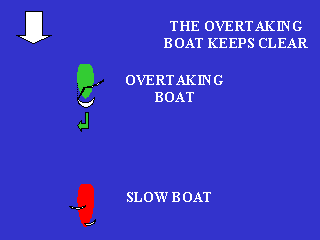Rule 11
All the Rules in Section II must be known well enough by anyone who runs a boat that you do not even have to think about them when you encounter another vessel. The only way to learn them that well, is to work out which is the right of way vessel and which the give way vessel, every time you get close to another craft-even if there is no risk of collision. Eventually you will do it instinctively! It is probably a good idea to ask the crew the same thing, an efficiently run boat need everyone keeping a lookout.
If you are running a power-driven vessel you still need to know the rules for sailing boats, because you must be able to decide how they will manoeuvre around each other. In the crowded waters most of us sail in, it is common to be avoiding several vessels of different classes at the same time. The same thing applies to sailing vessels with regard to the rules for power-driven vessels, although, of course in a sailing yacht you will probably be a power-driven vessel at some time.
As this rule says, the rules in this section only apply when the other vessel can be seen by eye.
The rules of this section do not apply if you have only heard the other vessel (perhaps in poor visibility) or detected it on a radar screen.
In both these situations there may no way of knowing for certain the class of the other vessel and Rule 19 must be applied.
Rule 12
Sailing boats priority is based on the tack that the vessels are on. They are always either on port tack or starboard tack.
 |
 |
 |
 |
 |
 |
Part iii of this Rule, deals with the unusual situation when you can not tell which tack the other vessel is on. This could occur at night or where the foresail of the other vessel obscures everything else (such as with a spinnaker).
 |
In this situation,
a vessel on port tack can not decide if the other vessel is
on port tack (in which case they would give way), or on starboard
tack (in which case they will stand on). As the situation is
in doubt, the leeward vessel must give way in plenty of time. |
Sailtrain.co.uk is free to use, but if you feel you would like to contribute to the running and development costs you can donate via Paypal:
Additional Resources:

